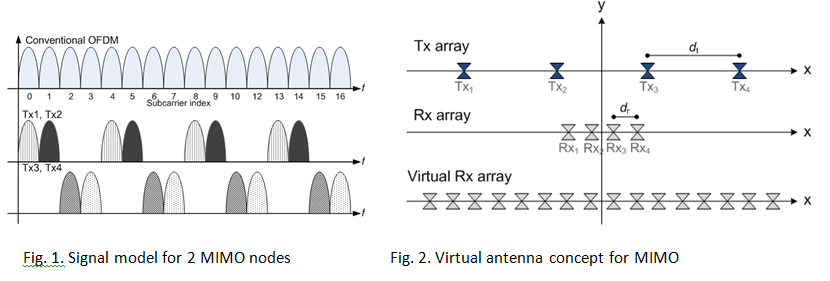The MIMO Radar Project
- Forschungsgebiet:MIMO Radar, Beamforming, Antenna arrays
- Typ:Bachelor-, Diplom- oder Masterarbeit
- Datum:ab Mai 2014
- Betreuer:
-
Introduction:
Based on the novel OFDM-based radar developed in IHE [1], we now extend the functionality of this radar to a multiple-input-multiple-output (MIMO) configuration so that this radar can also perform angular estimation (in the azimuth and elevation) besides range and Doppler estimation. The modified OFDM signal model for this new MIMO configuration is shown in [2]. The system concept for radar imaging using the MIMO configuration and angular estimation can be found in [3].
The original intended application for this radar was in the automotive field. However our research have found that this OFDM-based radar has the potential to be used in a networked radar system for area surveillance especially in mission critical fields where there is poor visibility or radioactivity, which prevents direct human effort. For the networked radar systems, each radar node is a MIMO system with multiple antennas and there are several nodes within one network. As such the signal model to cater to these multiple MIMO systems in a way which – i) mitigates mutual interference between nodes ii) retain the range and Doppler estimation capability of each node, and iii) enhances the overall angular estimation capability; is of utmost importance.Work to be done:
1. Characterization of orthogonal signals for the MIMO Radar System
This project aims to investigate the properties (i.e. autocorrelation, cross-correlation) of various orthogonal signals for use in the MIMO OFDM-based radar. The work consists of implementing the various orthogonal signals in MATLAB and simulating their behavior in a basic radar setup. The Doppler behavior of these signals will also be investigated. A fair comparison must be made for all signals under investigation. The simulations are then to be verified by measurement. Therefore the student will also be exposed to the handling of our measurement equipment, which includes the signal generator, mixer, network analyzer and also antennas.
This project is geared more towards Bachelor thesis students.
2. OFDM-based signal model for multiple emitter configuration systems
This research work deals with the analysis of the OFDM-based signal model and antenna array characteristics for multiple-transmitter systems. The goal is to analyze the effect of the antenna array characteristics on the OFDM-based radar angular estimation.

Fig. 1 shows an example signal model used for 2 MIMO OFDM radar nodes, each with 2 transmitters. The channel/subcarrier assignment of the signal bandwidth to the multiple nodes within the network will influence the outcome of the radar estimation, especially the angular estimation. Since the signals are orthogonal (uncorrelated) to each other, they can be sent simultaneously (as opposed to requiring time switching such as in FMCW radars). Based on the novel radar algorithm developed, multiple objects can be detected with just one cycle of the transmission.
Fig. 2 shows the concept of ‘virtual antennas’ conventionally used in MIMO system processing. Should we have 4 transmitters (Tx) and 4 receivers (Rx), denoted as 4x4, the equivalent virtual antennas at the signal processing side will look like 1x16. This means that with N+M number of physical antennas, we can source NxM results. Conventionally the more receive results at the receiver, the better the radar estimation. The element spacing, number of Tx and Rx in the antenna array, etc, will determine the angular range of vision for the radar (based on the resulting antenna radiation pattern). Angular estimation is done based on tracking the minor phase differences between the received signal from all the antenna array elements.
Combining the signal model in Fig. 1 and the virtual antennas in Fig. 2, we can expect an enhanced radar model in terms of the reduction of hardware, as well as enhanced angular estimation in terms of accuracy.Pre-requisites:
This project consists of i) the theoretical part for the signal model analysis, ii) the system level simulation in MATLAB, and iii) measurement verification work using standard measurement equipment. Hence the candidate will require the following skills for a successful attempt at the research:
- Good knowledge of coding in MATLAB
- Basic signal processing and OFDM background
- Fundamentals of radar systems
- Knowledge of antennas and propagation
What the student will learn/gain:
- Exposure to how advanced radar system works including the effects of the signal model and physical antennas
- Ability to interpret radar and antenna equations intuitively and relate them to the scenario
- How to set up a radar and the do measurements using conventional measurement equipment e.g. spectrum analyzer, signal generator, vector network analyzer, etc.
- How to verify the measurement with theoretical results
References:
[1] C. Sturm, T. Zwick, and W. Wiesbeck, “An OFDM System Concept for Joint Radar and Communications Operations,” in Vehicular Technology Conference, 2009. VTC Spring 2009. IEEE 69th, Apr. 2009, pp. 1 –5.
[2] C. Sturm, Y. L. Sit, M. Braun, and T. Zwick, “Spectrally interleaved multicarrier signals for radar network applications and multi-input multi-output radar,” Radar, Sonar Navigation, IET, vol. 7, no. 3, pp. 261–269, 2013.
[3] Y. L. Sit, T. Nguyen, C. Sturm, and T. Zwick, “2D Radar Imaging with Velocity Estimation using a MIMO OFDM-Based Radar for Automotive Applications,” in European Radar Conference, Nurnberg, Germany, Oct. 2013.

